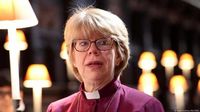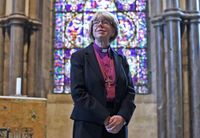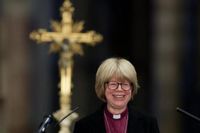History was made on October 3, 2025, when Sarah Mullally was announced as the next Archbishop of Canterbury, marking the first time in the Church of England’s 1,400-year history that a woman will hold the church’s highest post. Mullally’s appointment, following 105 male predecessors since St. Augustine in 597, signals a seismic shift not only in Anglican leadership but also in the broader landscape of global religious authority.
At 63, Mullally brings a unique background to the role. Before her ordination as a priest in 2002, she served as England’s chief nursing officer, a career that honed her skills in leadership, crisis management, and compassion. Her journey through the ranks of the Church of England was itself historic—she was among the first women consecrated as bishop in 2015, later becoming Bishop of London in 2018. Now, as she prepares for her formal installation at Canterbury Cathedral in January 2026, the world watches as she steps into a role that is both ceremonial and deeply influential, leading 85 million Anglicans across 165 countries.
The announcement came as the church faces daunting challenges. Mullally succeeds Justin Welby, who resigned in November 2024 after an independent investigation found he failed to report abuse allegations involving a church volunteer. The shadow of abuse scandals, declining attendance, and ongoing debates over the church’s stance on women and LGBTQ members loom large. According to the Associated Press, Andrew Graystone, an advocate for survivors of church abuse, observed, “The new archbishop will be faced with declining church attendance, bloated management structures and clergy squabbling over what people do in the bedroom. But the biggest challenge for the new archbishop is to restore trust after a decade of abuse scandals.”
In her first public remarks from Canterbury Cathedral, Mullally addressed these challenges head-on, opening with a prayer and a reflection on the uncertainty the church and society face. She spoke about her commitment to follow Christ and spread his message, but also tackled contemporary issues, such as political divisions over migration and a contentious bill in Parliament on assisted dying—a measure she opposes. She did not shy away from recent events, condemning the “horrific violence” of the October 2 synagogue attack in Manchester on Yom Kippur, the holiest day in the Jewish calendar. “We are witnessing hatred that rises up through fractures across our communities,” she said. “I know that the God who is with us draws near to those who suffer. We then, as a church, have a responsibility to be a people who stand with the Jewish community against antisemitism in all its forms. Hatred and racism of any kind cannot be allowed to tear us apart.”
Mullally also acknowledged her place in church history, expressing gratitude for the women who paved the way for her and pledging to be a “shepherd in the church to enable the faith and practices of others.” She was candid about the magnitude of her new responsibility, stating, “I will not always get things right. But I’m encouraged by the psalmist who tells us that ‘Though you stumble, you shall not fall headlong, for the Lord holds you fast by your hand.’ I trust in the truth of those words for me, for you, for the Church of England, for the nation.”
Her appointment was formally announced by Prime Minister Keir Starmer’s office after King Charles III gave his consent, in keeping with centuries of tradition. Starmer welcomed the news, saying, “The Church of England is of profound importance to this country. Its churches, cathedrals, schools and charities are part of the fabric of our communities. The Archbishop of Canterbury will play a key role in our national life.” King Charles also offered his congratulations, noting the worldwide significance of her role.
The process that led to Mullally’s selection was anything but swift. According to the Associated Press, it stretched over 11 months and was chaired by the former director-general of MI5, Britain’s domestic intelligence agency. Unlike the conclave that elects a pope, the selection of an Archbishop of Canterbury is a more opaque affair, with no public shortlist or open vote. Instead, it’s a slow, consultative process involving various interest groups and senior church officials.
Mullally’s rise comes after reforms introduced eleven years ago finally allowed women to be considered for the role. The Church of England only began ordaining female priests in 1994 and consecrated its first female bishop in 2015. While her appointment is a major breakthrough, it also underscores how rare female leadership remains in global religious institutions.
Looking across the religious spectrum, the Associated Press notes that while some mainline Protestant churches in the United States have had female leaders—such as Katharine Jefferts Schori, who became presiding bishop of the Episcopal Church in 2006, and the Rev. Elizabeth Eaton of the Evangelical Lutheran Church in America—many major denominations remain male-dominated. The Southern Baptist Convention, for instance, continues to bar women from serving as pastors. In historically Black Christian denominations, women have been ordained since the 19th century, but top leadership positions have only recently opened to women, and even now, they remain exceptions.
The Catholic Church, meanwhile, continues to bar women from ordained ministry, though Pope Francis has promoted several nuns to senior Vatican positions and granted women the right to vote at synods. The Church of Jesus Christ of Latter-day Saints maintains an all-male priesthood, and Orthodox Judaism in Israel, which dominates religious life there, also restricts top leadership roles to men. In Islam, while some women serve as scholars and judges, leadership of mixed-gender congregational prayers and top formal positions remain almost exclusively male, though debates and incremental changes continue in some communities.
In Hinduism and Buddhism, authority is decentralized and varies across sects, but women leaders like Mata Amritanandamayi and several Buddhist abbesses have emerged, though male dominance persists. Sikhism, too, is largely male-led, but figures such as Bibi Jagir Kaur, the first female president of its main governing body, and women-led kirtan groups in North America are slowly shifting the landscape.
Within this global context, Mullally’s appointment as Archbishop of Canterbury stands out as a landmark not just for Anglicans but for women in faith leadership worldwide. Yet her journey is just beginning. As she prepares to take the helm in January, she faces the formidable task of guiding a diverse and often divided church into a new era—one that, perhaps, will be shaped by her vision of inclusion, healing, and hope.


